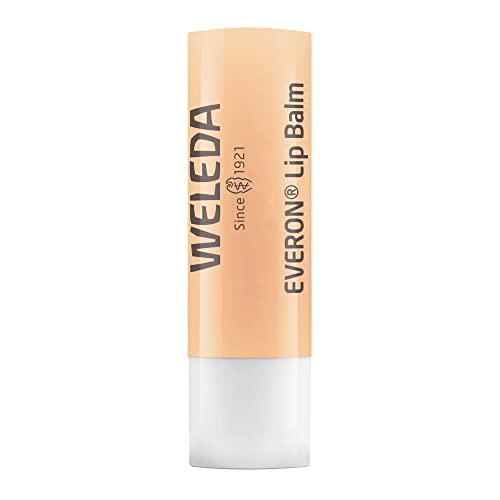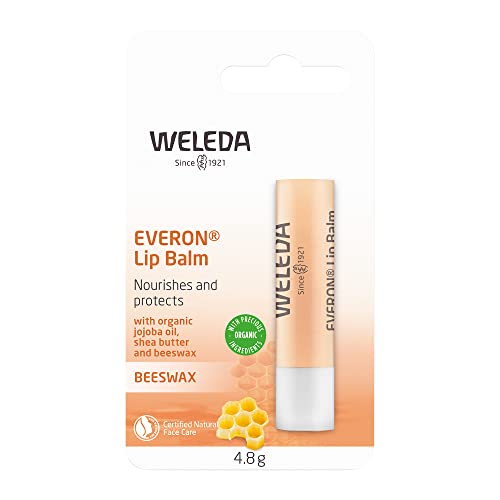


Weleda Everon Lip Balm - Nourishing Moisture & Protection with Organic Jojoba Oil - 0.17 oz


Fragrance
High RiskFragrance refers to a mixture of aromatic compounds used in products to provide scent. It is commonly listed as 'fragrance' or 'parfum' on product labels and can serve various functions, including enhancing user experience and masking undesirable odors.
Sustai Insights
Fragrance offers functional benefits by improving product appeal; however, it poses significant health risks, notably a high likelihood of causing allergies and allergic contact dermatitis. Environmental risks include potential pollution and endocrine disruption, though its overall carcinogenicity is low. Regulatory bodies have noted concerns regarding its use, leading to a high-risk classification. Safe usage practices should be observed, and alternatives such as natural essential oils are recommended for those sensitive to synthetic fragrances.
Rosa Damascena (Rose) Flower Wax
Low RiskRosa damascena (rose) flower wax is a natural wax derived from the petals of the Rosa damascena plant. It serves primarily as an emulsifier and thickening agent in cosmetic formulations, contributing to product texture and stability.
Sustai Insights
Rosa damascena flower wax exhibits functional benefits, such as enhancing product consistency and providing a protective barrier on the skin. It is considered low risk for health concerns, with negligible carcinogenicity, allergenic potential, or reproductive toxicity. Environmentally, it poses minimal risks and is not categorized as a pollutant. Regulatory agencies do not impose restrictions on its use. Overall, the ingredient is assessed as low risk, making it a suitable option in cosmetic products.
Simmondsia Chinensis (Jojoba)
Low RiskSimmondsia chinensis, commonly known as jojoba, is an oil derived from the seeds of the jojoba plant. It is commonly used in cosmetic formulations for its moisturizing properties, acting as an emollient and skin conditioning agent.
Sustai Insights
Jojoba oil offers functional benefits such as effective skin moisturization and is biodegradable, with sustainable sourcing practices. Health risks are low, with minimal concerns regarding carcinogenicity, allergies, and reproductive toxicity. Environmental impact is negligible, with no pollutant or bioaccumulation potential. Regulatory status is favorable with no significant restrictions noted. Overall, it is assessed as low risk, and safe usage practices should be maintained. Alternatives include other plant-derived oils like argan or almond oil, which may provide similar benefits.
Butyrospermum Parkii (Shea) Butter
Low RiskButyrospermum parkii (shea) butter is a vegetable fat derived from the nuts of the shea tree. It is commonly used in cosmetic formulations for its emollient properties, providing moisture and improving skin texture. Additionally, shea butter is known for its ability to enhance the stability of products and deliver a creamy texture.
Sustai Insights
Shea butter offers functional benefits as an effective moisturizer, enhancing skin barrier function and texture. It is sustainably sourced and biodegradable, contributing to eco-friendliness. Health-wise, it is associated with low risks for carcinogenicity, allergies, and reproductive toxicity. Environmental impacts are minimal, with no significant pollutant potential identified. Regulatory assessments indicate no current restrictions. Overall, the ingredient presents a low risk, making it a favorable choice in cosmetic formulations.
Beeswax, Yellow
Low RiskBeeswax, yellow, is a natural wax produced by honeybees, primarily composed of esters of fatty acids and long-chain alcohols. It serves as an emulsifier, thickener, and stabilizer in cosmetic formulations, contributing to texture and consistency. It is commonly used in creams, balms, and lip products.
Sustai Insights
Beeswax provides functional benefits such as enhancing product texture and acting as a natural emulsifier, while also being biodegradable and sustainably sourced. Health risks are minimal, with low concerns for carcinogenicity, allergies, or irritations. Environmental impacts are also low, as it does not bioaccumulate. Regulatory status remains favorable with no current restrictions. Overall, the ingredient poses low risk, making it a suitable choice in cosmetic formulations.
Euphorbia Cerifera (Candelilla) Wax
Low RiskCandelilla wax is extracted from Euphorbia cerifera, a shrub native to northern Mexico and the southwestern United States. It is primarily used as a thickening agent, emollient, and film-forming agent in cosmetic and personal care products.
Sustai Insights
Candelilla wax serves effectively as a natural thickener and emollient, contributing to product texture and moisture retention. It is biodegradable and sourced sustainably, supporting eco-friendly formulations. Health risks are low, with minimal concerns about sensitization. Environmental hazards are also low, with no significant pollutant or bioaccumulation potential noted. Regulatory bodies impose few restrictions, indicating overall low risk. Safe usage practices should be followed, and alternatives like carnauba wax may be considered for those seeking different plant-based options.
Rosa Damascena (Rose) Flower Wax
Low RiskRosa damascena (rose) flower wax is a natural wax derived from the petals of the Rosa damascena plant. It serves primarily as an emulsifier and thickening agent in cosmetic formulations, contributing to product texture and stability.
Sustai Insights
Rosa damascena flower wax exhibits functional benefits, such as enhancing product consistency and providing a protective barrier on the skin. It is considered low risk for health concerns, with negligible carcinogenicity, allergenic potential, or reproductive toxicity. Environmentally, it poses minimal risks and is not categorized as a pollutant. Regulatory agencies do not impose restrictions on its use. Overall, the ingredient is assessed as low risk, making it a suitable option in cosmetic products.
Simmondsia Chinensis (Jojoba)
Low RiskSimmondsia chinensis, commonly known as jojoba, is an oil derived from the seeds of the jojoba plant. It is commonly used in cosmetic formulations for its moisturizing properties, acting as an emollient and skin conditioning agent.
Sustai Insights
Jojoba oil offers functional benefits such as effective skin moisturization and is biodegradable, with sustainable sourcing practices. Health risks are low, with minimal concerns regarding carcinogenicity, allergies, and reproductive toxicity. Environmental impact is negligible, with no pollutant or bioaccumulation potential. Regulatory status is favorable with no significant restrictions noted. Overall, it is assessed as low risk, and safe usage practices should be maintained. Alternatives include other plant-derived oils like argan or almond oil, which may provide similar benefits.
Butyrospermum Parkii (Shea) Butter
Low RiskButyrospermum parkii (shea) butter is a vegetable fat derived from the nuts of the shea tree. It is commonly used in cosmetic formulations for its emollient properties, providing moisture and improving skin texture. Additionally, shea butter is known for its ability to enhance the stability of products and deliver a creamy texture.
Sustai Insights
Shea butter offers functional benefits as an effective moisturizer, enhancing skin barrier function and texture. It is sustainably sourced and biodegradable, contributing to eco-friendliness. Health-wise, it is associated with low risks for carcinogenicity, allergies, and reproductive toxicity. Environmental impacts are minimal, with no significant pollutant potential identified. Regulatory assessments indicate no current restrictions. Overall, the ingredient presents a low risk, making it a favorable choice in cosmetic formulations.
Fragrance
High RiskFragrance refers to a mixture of aromatic compounds used in products to provide scent. It is commonly listed as 'fragrance' or 'parfum' on product labels and can serve various functions, including enhancing user experience and masking undesirable odors.
Sustai Insights
Fragrance offers functional benefits by improving product appeal; however, it poses significant health risks, notably a high likelihood of causing allergies and allergic contact dermatitis. Environmental risks include potential pollution and endocrine disruption, though its overall carcinogenicity is low. Regulatory bodies have noted concerns regarding its use, leading to a high-risk classification. Safe usage practices should be observed, and alternatives such as natural essential oils are recommended for those sensitive to synthetic fragrances.
Beeswax, Yellow
Low RiskBeeswax, yellow, is a natural wax produced by honeybees, primarily composed of esters of fatty acids and long-chain alcohols. It serves as an emulsifier, thickener, and stabilizer in cosmetic formulations, contributing to texture and consistency. It is commonly used in creams, balms, and lip products.
Sustai Insights
Beeswax provides functional benefits such as enhancing product texture and acting as a natural emulsifier, while also being biodegradable and sustainably sourced. Health risks are minimal, with low concerns for carcinogenicity, allergies, or irritations. Environmental impacts are also low, as it does not bioaccumulate. Regulatory status remains favorable with no current restrictions. Overall, the ingredient poses low risk, making it a suitable choice in cosmetic formulations.
Euphorbia Cerifera (Candelilla) Wax
Low RiskCandelilla wax is extracted from Euphorbia cerifera, a shrub native to northern Mexico and the southwestern United States. It is primarily used as a thickening agent, emollient, and film-forming agent in cosmetic and personal care products.
Sustai Insights
Candelilla wax serves effectively as a natural thickener and emollient, contributing to product texture and moisture retention. It is biodegradable and sourced sustainably, supporting eco-friendly formulations. Health risks are low, with minimal concerns about sensitization. Environmental hazards are also low, with no significant pollutant or bioaccumulation potential noted. Regulatory bodies impose few restrictions, indicating overall low risk. Safe usage practices should be followed, and alternatives like carnauba wax may be considered for those seeking different plant-based options.
Experience the soothing touch of Weleda Everon Lip Balm, expertly crafted to moisturize and protect your lips. This nourishing lip treatment features organic jojoba seed oil that envelops your lips in hydration for a soft, smooth finish.
- Moisturizing Protection: Formulated with organic ingredients, this balm offers essential moisture and protection against dryness, making it ideal for daily use.
- Natural Ingredients: Enriched with jojoba seed oil, shea butter, and rose wax, it nourishes while being free from synthetic additives, ensuring a natural care experience.
- Gentle on Skin: The calming properties of rose extract help soothe sensitive lips, providing relief and comfort to delicate skin.
- Versatile Use: Perfect for any occasion, apply it before bed for overnight nourishment or throughout the day for continuous hydration.
- Ethically Sourced: Weleda is committed to sustainability, using plant-based ingredients to create effective products that care for you and the planet.
With Weleda Everon Lip Balm, indulge in a lip care solution that aligns with your values while delivering exceptional results.
Subscribe & Save with Sustai
- Best Price Guarantee: Always enjoy the lowest prices on sustainable home essentials.
- No Surprises: We’ll notify you before shipping. No hidden fees, ever.
- You’re in Charge: Change, pause, or cancel your subscription anytime with ease.
- Eco-Friendly Deliveries: Our grouped shipments mean less packaging and lower emissions.
Join us on a sustainable journey. Special offers for a limited time! Prices and promotions may change.
Recommended Products
Experience the soothing touch of Weleda Everon Lip Balm, expertly crafted to moisturize and protect your lips. This nourishing lip treatment features organic jojoba seed oil that envelops your lips in hydration for a soft, smooth finish.
- Moisturizing Protection: Formulated with organic ingredients, this balm offers essential moisture and protection against dryness, making it ideal for daily use.
- Natural Ingredients: Enriched with jojoba seed oil, shea butter, and rose wax, it nourishes while being free from synthetic additives, ensuring a natural care experience.
- Gentle on Skin: The calming properties of rose extract help soothe sensitive lips, providing relief and comfort to delicate skin.
- Versatile Use: Perfect for any occasion, apply it before bed for overnight nourishment or throughout the day for continuous hydration.
- Ethically Sourced: Weleda is committed to sustainability, using plant-based ingredients to create effective products that care for you and the planet.
With Weleda Everon Lip Balm, indulge in a lip care solution that aligns with your values while delivering exceptional results.

You can have at most 2 Sustainable Steals products in your cart
Customer Reviews
Customers’ View
Customers appreciate the nourishing and hydrating qualities of this lip balm, noting its effectiveness in keeping lips soft and moisturized. Many users highlight its non-greasy formula and pleasant honey scent, making it a favorite for daily use. Common sentiments include, 'It's very moisturizing and lasts a long time,' reflecting satisfaction with its long-lasting hydration. Additionally, the product's natural ingredients, such as organic jojoba oil and shea butter, resonate well with health-conscious consumers looking for clean options without harsh chemicals. The eco-friendly packaging is also valued by those who are environmentally aware. Overall, customers find this lip balm to be a reliable solution for dry lips while aligning with their sustainable lifestyle choices.
AI-generated from the text of customer reviewsThis product has no reviews yet.




